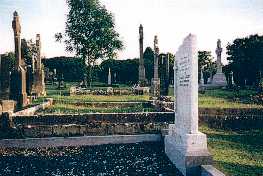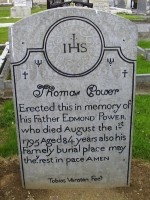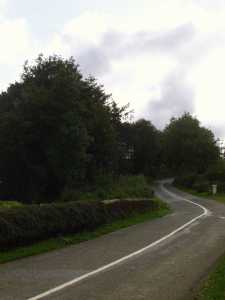
© Mahoonagh graveyard
Mahoonagh graveyard is located in the grounds of the abbey
ruin. The oldest headstones in this graveyard are located closest to
the abbey ruin. The graveyard was extended in the late 1960's.

© Headstone in Aglish graveyard
Aglish graveyard is on the site of the former monastery.
This graveyard is still in use and the oldest headstone in the graveyard
is reputed to be from 1760. The oldest headstone that we came across
was from 1788 in memory of Thomas Fitzgerald. One of the oldest headstones
that we came across was this one from 1795, in memory of Edmond Power.
It is possible that there are older graves in the cemetery,
as many of the graves were marked with marker stones, which do not bear
inscriptions. Indeed the practice of using headstones to mark individual
graves did not become popular until the eighteenth century. Some of
the headstones face the field and not the road, which could indicate
that the monastery was further away from the road.
The graveyard was cleaned up in 1949 by Muintir na Tíre.
It took three months of hard work to clear the graveyard of trees and
to lay the cement paths. All of the work was done voluntarily. Today,
the graveyard is in good condition.
There is a Famine graveyard in Boithre na Cealla (road
to the church) at Clooncourivane about a mile from the roadside. This
site is also called Gurrane. A commemorative plaque was recently erected
to mark the site. The inscription on the plaque reads:
Ní Hé Dia a cheap Riamh an Obair Seo
In Memory of All the People who were buried here in
Boithre na Cealla Cemetery
During and after the Famine years (1845-1849)
Daoine Bochta cur le Fuacht is le Fah
Erected by Castlemahon History Society Group February
1999
Unveiled by President Mary McAleese on June 9th 1999
There was also a burial place for unbaptized children
as the site is sometimes called Killeen. Small straight stone markers
indicated the graves. Approximately 200 people are believed to be buried
here. The ruins of a monastery (believed to be Augustinian) were present
up to twenty years ago when the stones were removed. This site may have
been situated at Killila Bridge.

© Killila Bridge
There is a second Famine graveyard at Ballinakill in a
place called Donoghue's field, which is now owned by Padraig Cagney.
There are approximately 50 people buried here in a mass grave. The cause
of their deaths was yellow fever. Although the people buried here did
not die from famine, it is remembered locally as a famine graveyard
because the deaths occurred around this time. There was believed to
be a mass rock on or near the site.


Website by Lúnasa
Design